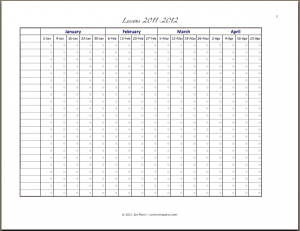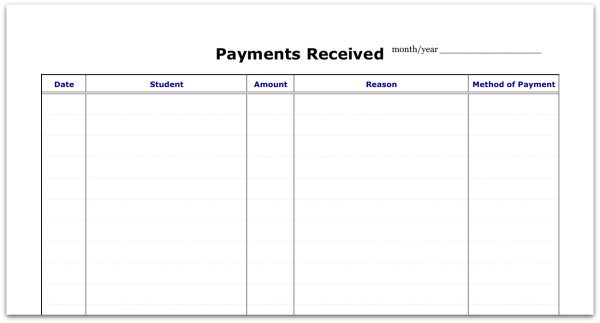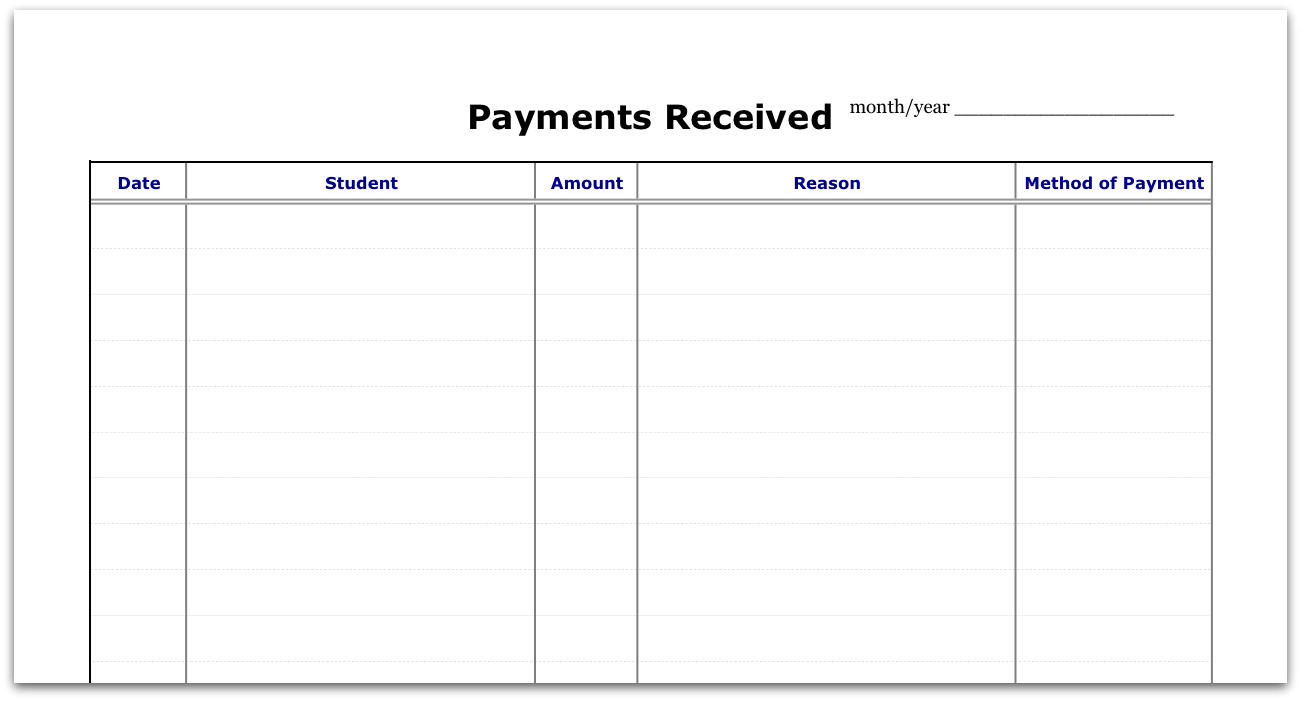I have just finished updating two of the studio business forms from the Printables page.
The first one is the Record of Lesson Attendance & Payment pdf — I have updated the dates for use for the 2013-2014 school year. I received a number of requests from teachers to make this form available again this year, and I am happy to do so!
Here is how the form works: Write your students’ names in the first column. Each week, write the lesson date (in a month / date format) in the column for that week. This is how you can track attendance. The small circles in each cell are where you can write checkmarks indicating tuition payments. Whether you charge by-the-week or by-the-month, you can place a checkmark by each paid lesson date.

The second form that I updated is called the Record of Payments Received pdf. I print one of these sheets every month and put it into my 3-ring binder. I write the month/year in the blank at the top and then fill in all of my students’ names. As I receive monthly tuition payments from each student, I record the date, amount, and check number. Under “reason,” I write “September tuition” or whatever the case may be.
At the bottom on the sheet, there is usually extra room where I can record other income for that month, such as if I play for a wedding or speak for a piano teachers’ association. At the end of each month, I can easily total up all of the payments to see my income for the month. (To see my actual net income for the month, I would need to subtract my expenses — which I track in a separate Excel spreadsheet.)

Over the past couple of years, I have had little need for the first form mentioned in this post. While I was a college student, I had a lenient make-up/cancellation policy (which was suitable for me at the time, because my college schedule caused me to need to cancel lessons as much as my students did). At the time, that form was a huge help with keeping track of everything!
After grad school, I obviously became much more dependent on my income so it became necessary to run my studio differently So, my make-up policy is currently this: “Due to the teacher’s limited availability, makeup lessons cannot be guaranteed.” This is a very nice way to basically say that I do not offer make-up lessons — except in rare cases, at my own discretion.
After grad school, I also adapted a flat monthly fee for charging tuition (as advised by a colleague of mine). It is one of the best decisions I’ve ever made for my piano teaching. The simple change to a flat rate (and calling it “tuition”) has helped students/parents get the idea that they are paying to reserve a weekly time slot in my schedule, versus paying me for actual given contact time during the lesson (read this article for more on that). If students decide to cancel a lesson in order to attend a birthday party or go on vacation, they certainly may do so but they still owe the monthly tuition as usual.
I liked the idea of keeping things simple with a flat monthly rate SO much, that I decided to charge a yearly registration fee that would cover the cost of books/materials throughout the year. I love the simplicity of this! Of course, I do have to keep track of how much I have spent in books each year for each student, so that I know that my registration fee is appropriate. But I no longer have to contact parents to get reimbursement for books or keep track about whether they have paid or not. This system works great for me. The other option, of course, is to have students purchase their own books.
Here is one more plus to charging a flat tuition rate: It makes it easier to raise your rates incrementally each year. (Remember, if you do not raise your rate each year, you are actually making less than you did the previous year due to the ever rising cost-of-living.)
This year, I raised my monthly tuition by $2 to cover the cost of living and to give myself a tiny raise. If I were still charging a per-lesson rate, I would have probably raised the per-lesson fee by a dollar — which is a pretty large increase that cannot be sustained year-after-year throughout a teaching career. I think this is why teachers sometimes do not raise their rates for 3-5 years at a time — because they realize it would be too great of an increase to do it every year (and for some reason they do not want to increase their rates by 50 cents or some such odd amount). It is better, I think, to teach our students/parents to expect small raises in the rate every year. The price of everything else in the world slowly goes up, and parents should not be surprised that the cost of lessons goes up each year.
I’m sure many of you charge tuition in a similar way and have similar policies, but I thought I would share in case there are any teachers out there looking for a better system! The most important thing is that every teacher must find a system that works appropriately for you and treats everyone fairly — you, your students, as well as the rest of the piano teaching profession.
What works for you? Please share in the comments below.



Thanks for the advice, Joy!
My prices have been stagnant for years but I have been hesitant to raise them too dramatically for fear of alienating the parents.
My initial thought is – if you never raise them, the parents will never adjust. Is there such a thing as a non-dramatic raise?
Also – have some confidence in your self and your teaching ability. Do you think so little of the value of your services that you don’t think they are worth a raise after years of stagnation? It does feel like a risk, but in reality, you owe yourself and your students a full wage. If you have had students for years, then they see value in your services. Hopefully that will help you build the confidence you need.
prices go up a little every year. fees are in two annual semesters with summer optional. Fee for September through January is due July 1, which clarifies how many spots are open for new students. Fee for February through June is due December 1. This works very well in terms of commitment.
I have families ask me if I give discounts for more than one student in a family. Do you offer this, and if so how do you decide how much?
Many teachers do not give sibling discounts because the time is the same to the teacher — after all, you could fill the same time slots with non-siblings and make more money! Besides, it is hard enough to make a living as a piano teacher, so why should we hand out discounts? This is a good point — however, if you are trying to build your studio, you have to get creative sometimes. If you DO decide to give a sibling discount, I would not give it for 2 siblings — only 3 or more. And it should be a very small discount — not enough to hurt your income but enough that the family feels appreciated. I currently give a discount of $20 off the total monthly bill if there are 3 siblings or more. I might do-away with this discount once my studio is full.
This is also what I do: give a small discount (I call it a scholarship because I don’t like the implication that ‘discounted’ lessons are lower quality) for 3 or more siblings, only if they ask, and only for good, proven, ongoing students. Never offer it up front or give to new, untried students.
Because I travel to the student’s homes, I give a discount at 3 students and at 5 students. I would honor this discount if some of my families wanted to combine lessons at one home, since having multiple students at one location DOES help me make more money in the long run.
I think a travel discount totally makes sense. But I still wouldn’t offer it unless they ask! 😉
Hi Joy! I love this topic because it can vary so much based on the teacher’s experience, training, region, etc. I understand the policy behind no make-up lessons or refund when a student cancels, but I am curious how you handle it when you have to cancel? Even though I cancel lessons only once or twice per year, I have had parents balk about paying for something they aren’t getting. I am sure that I need to change my culture a little bit, and changing to monthly tuition rather than “pay-per-lesson” may help. How often do you take time off and does your tuition rate reflect those situations?
I would also love to know what other teachers who read this do in their businesses.
I have a number of “flex weeks” built into the schedule. If I do not use all of the flex weeks during the course of the school year, the student benefits by receiving those lessons for free. In the event that I need to cancel a lesson (for illness, family emergency, conference attendance, etc.), I can either make-up the lesson or use one of my flex weeks. No matter what, I guarantee that I will be available to teach 44 lessons each year. It works great!
This is what I am working on today. My current piano moms are thinking that my pay raise is so within reason and the rate for new students will be higher…I am giving a “scholarship” for current families to give them time to catch their rate up over a few years. It is that or I need to get a different job. I am starting with a school of music, as well, and the director said my rates were way to low and I needed to raise them at my home studio.
I bill families once a month, but I check how many lessons there will be for that month. That way they only pay for lessons that they get, and they’ve already paid me in case they cancel at the last minute. When I cancel I take it off the next month’s bill.
Good advice ad gently put, Joy. Your encouragement to have a flat tuition fee and registration fee for materials throughout the year work well for me too. Raising rates a little each year is also a question that Wendy’s form on “Where your Music tuition goes” explains this to parents. Then they can understand the many costs besides a teacher’s lesson times or materials. Thanks!!
Hello! I’m a violin and piano teacher overwhelmed by the number of students who are missing for spring break, and I would like to restructure my studio to a flat fee. However, I’m concerned that many students may say, “well, I’ll be gone for two weeks in June so I just won’t pay for the month of June and I’ll return in July.” How do you handle that when it happens?
It is up to you how you would like to handle this kind of situation. I would recommend explaining that you cannot afford to hold their slot in the schedule until they return. If the students decides to take their chances, it is then up to you whether you want to actually fill the slot with a student from your waiting list.
The beauty of the flat fee system is that it generally INCREASES commitment to lessons because students/parents understand that their monthly tuition reserves their spot in your schedule. Most parents would respect the fact that you need to make an income and cannot afford to have students taking off a month here or there. If they do not understand this, perhaps they would be better suited to a teacher who prefers to charge by the week.
Whatever you do, do not allow the fear of what might happen be the basis of your business-related decisions, of course. Make decisions based on what you know will be best for you and your business. I daresay that you can be fairly sure that switching to a flat fee will be a wonderful and beneficial change for your business. Good luck!
Thank you, Joy! I implemented this system and I’m happy with it so far. Here’s a question that I recently received that I don’t know the answer to, though: a student asked if their “year” would run from May to May, since I just started this system in May. With students coming in at all times, I don’t think I can keep track of when everyone’s “year” began and will end, so I’m tempted to say that the system refers to the calendar year, and whenever you start is just when you start. But since the system is based on 44 lessons a year, I can see why they would ask that question. How do you handle that?
Hi Sarah,
You can have your year run any way that you like. Mine runs with the school year (September through August), but I know of other teachers who run it from January through December. If a student signs up mid-year, they just jump into the year at that point and make normal payments like everyone else. (Although I often pro-rate the registration fee.)
Hi Joy! Thanks so much for this resource; I tried to make one on my own and it didn’t look nearly as nice as yours! Are you going to be updating the Record of Lesson Attendance and Payment printable for the 2015/2016 year? It would be GREATLY appreciated!
Do you have policies or a contract you are willing to share?
Like it was for you when in college, you requested flexibility with your families regarding make-up lessons. I have a busy personal family schedule and occasionally ask for flexibility but at the same time I feel like I am overly lenient on my students.
I recently had a parent tell me “this just isn’t working” and take a month off in the middle of the year. I am just stumped as to how to handle this as I’m feeling very taken advantage of and that my time is not being appreciated or valued. I feel I need to get concrete policies in place to prevent this loss of income without notice going forward. If it was a dance studio or community ed program, they would not be able to just take a month off without payment. Do you charge an enrollment fee – if so is it annual for every student or just upon first enrollment and then recharged if a student takes a break like this? Any recommendations would be GREATLY appreciated
Any chance you’re ready to post at 2016-2017 version of this? It’s been very helpful this past year for my records!
Joy, are you going to update yourself record of attendance sheets. The teachers I work with love have hard copies. I appreciate your techie skills.